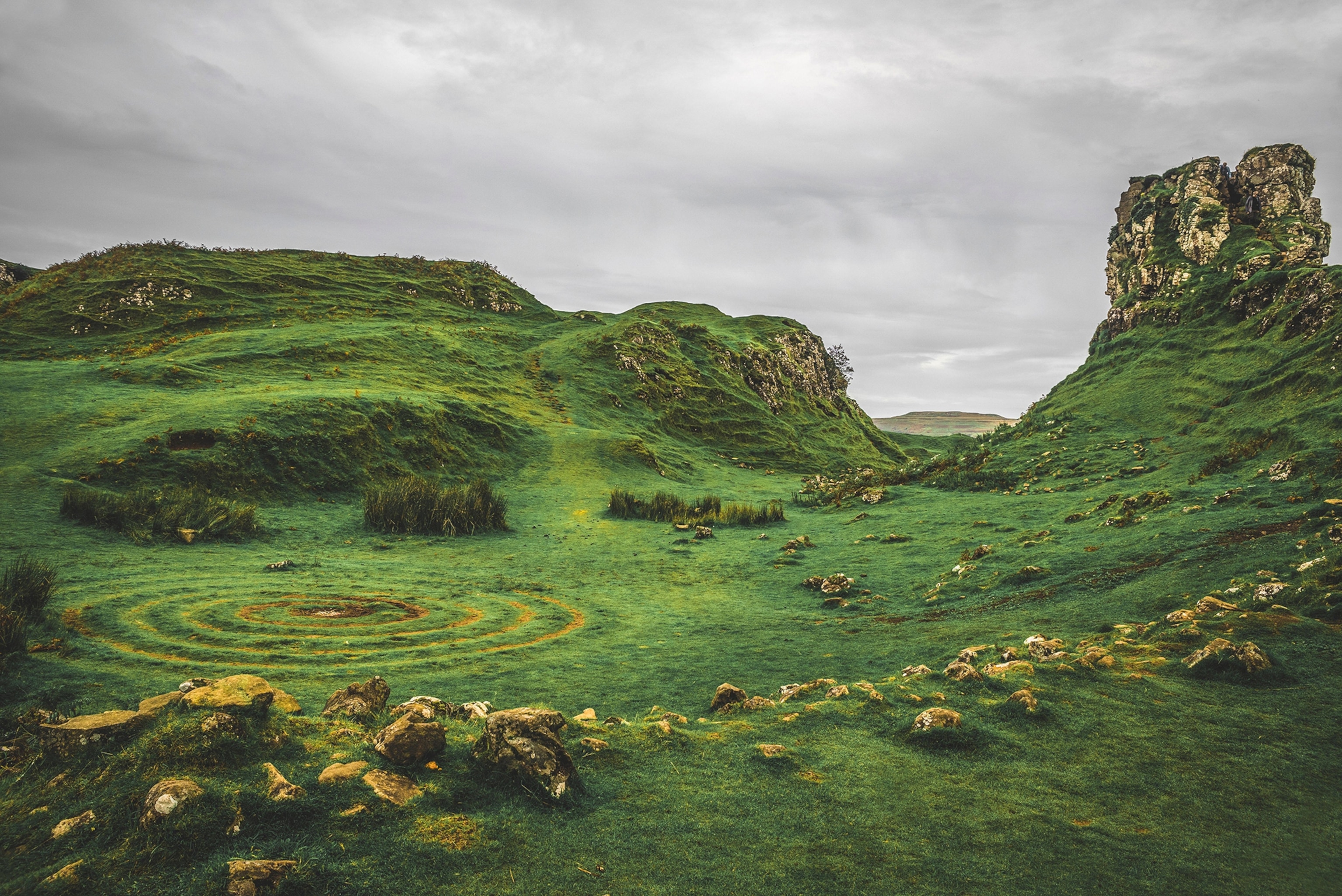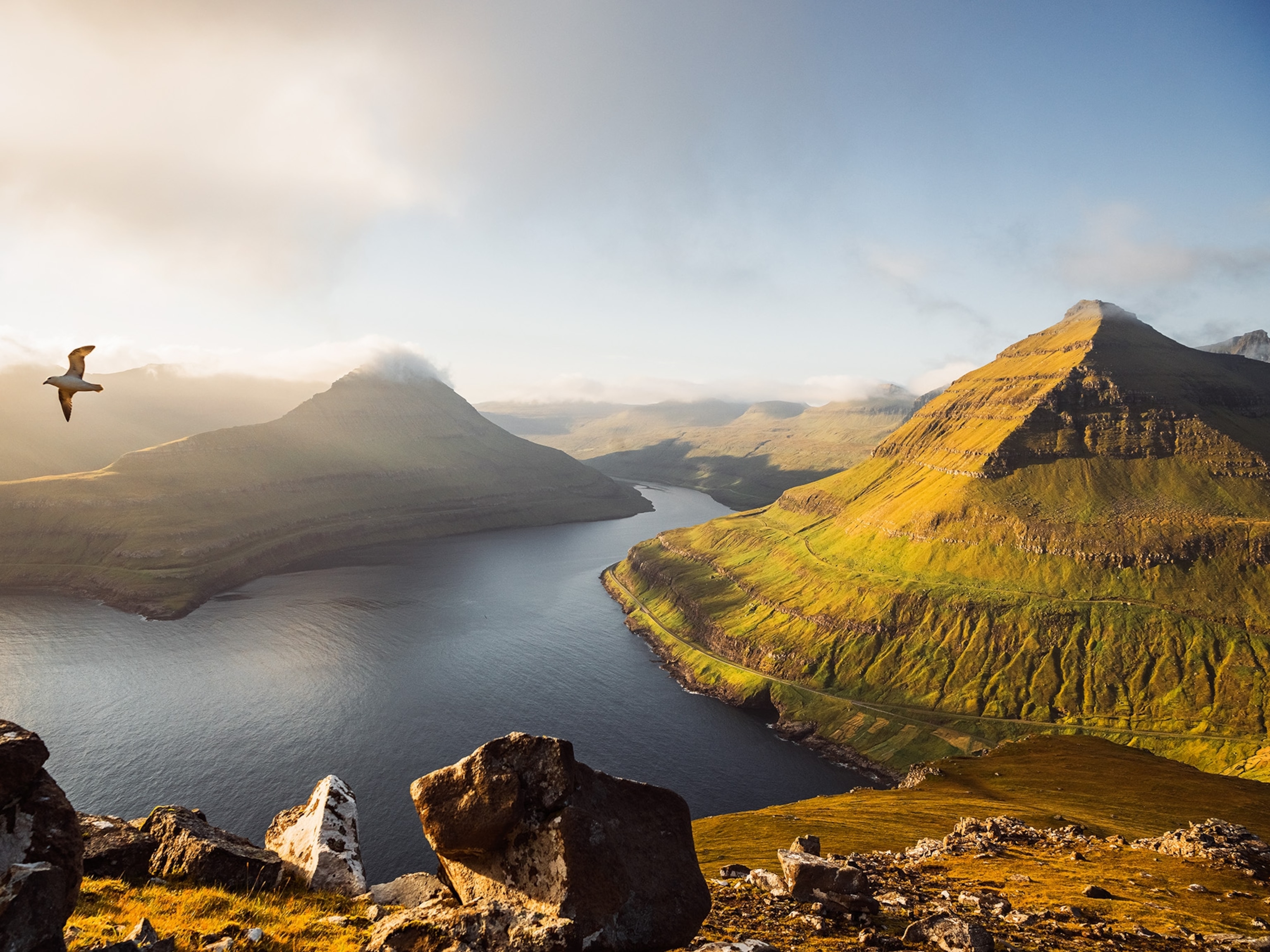Dunscaith Castle, a forbidding, 12th-century fortress, clings to the hillside for dear life, its crumbling walls tracing a broken line against the sky.
Across Loch Eishort, the dark peaks of the Cuillin mountains run across the horizon like a row of crumpled witches’ hats, snagging clouds as they pass. There’s barely another soul in sight; this corner of Scotland’s Isle of Skye haunted by little more than the wind ruffling the long, golden grass.
It’s clear why legendary Scottish warrior Scáthach chose this tucked-away-from-the-world spot to found her impenetrable college of martial combat. Promising students would come from far and wide to train in warfare and sorcery here, and to learn in secret from perhaps the greatest fighter the Celtic realms have ever known. But what ultimately happened to the powerful warrior queen Scáthach remains a mystery; the lack of any known tomb only adds to her mystique. Since the Middle Ages, legend has it that she’ll return when the world needs her most.
“It’s difficult to separate mythology and history on Skye,” says local tour guide Ciaran Stormonth. “I’m sure there probably was a woman called Scáthach, but how much is true? We just don’t know.”
Shaped like a raven’s wing spreading into the Sea of the Hebrides off the northwest coast of Scotland, Skye is a theater of natural drama, where legends like Scáthach’s have played out for centuries. It’s a suitable setting for tales of warriors and witches, given the brooding mountains, moorland, tumbling waterfalls, and loch-frayed coasts that hint at a violent, elemental past. Indeed, the weather on Scotland’s second-largest island is as dramatic as its landscapes, changing at a moment’s notice like the whims of a god. After all, it didn’t earn the nickname “Misty Isle” for nothing.
(You can see unicorns in this magical place.)
“Celtic nations have a rich heritage of storytelling,” says Stormonth. “Take fairies—they’ve been used for centuries as a way of explaining strange things that people didn’t understand, such as illnesses. True or not, it was a way of hiding the dangers of the world.”
On Skye, it seems, both legends and facts seem equally fantastical.
Language of the land
At Duncan House, tucked away off the road to the village of Elgol, craftsman Garth Duncan shows me his ornate Celtic jewelry: brooches, crests, and rings adorned with intricate, twisting patterns. Though originally from the United States, where he first took up silverwork, Duncan permanently relocated to Skye two decades ago, driven by old family ties. “I’ve Scottish heritage on my father’s side,” he explains, “although I never used to be interested by it. But then I looked into it and realized I wanted to keep these ancient traditions alive. Suddenly, I started creating these artifacts.”
Along with his son Gareth, Duncan works on commissions from all over the world. A selection of their wares is laid out like a mystical treasure trove: suits of armor, elaborate staffs, rings set with jewels and Skye marble, and knives with handles carved from 5,000-year-old bog oak.
(This country has the most castles in Europe.)
“I can’t imagine being anywhere else now,” says Duncan. “I like being up here, out of the way—I hear all the gossip from Elgol without having to be there.”
I head to the tiny harbor town of Elgol to meet father-son duo Seumas and Sandy MacKinnon, owners of Misty Isle Boat Trips, for a visit to the secluded Loch Coruisk. Hidden away across the water, the loch is most quickly reached by boat and—given that the alternative is a 10-mile hike from Elgol, involving a rocky scramble ominously known as the “Bad Step”—it’s arguably the easiest route, too.
With binoculars in hand, flame-haired Seumas points out seals and gannets en route.
“Look, there, quickly!” he cries, nodding to a pair of minke whales, whose fleeting appearance draws gasps from other passengers. Sightings of the cetaceans are never guaranteed, he says, although the same goes for some of the waters’ more fantastical residents. “They say there’s an ùruisg at Loch Coruisk,” Sandy says. “A half-man, half-goat that brings bad luck. If he finds you, don’t lead him back here—I don’t want anything to do with him.”
If it’s my attention the ùruisg wants, then he has Loch Coruisk to compete with. The lake is captivating, at once dramatic and serene—a silent, dark mirror into which the rough, bare peaks of the Cuillin are reflected with almost digital clarity. Boulders sit alone in the landscape like paperweights, and the faint cries of sea eagles echo around the hills. It’s so wildly atmospheric that Scottish writer Sir Walter Scott felt compelled to commit it to paper in his 1814 poem The Lord of the Isles, writing “Rarely human eye has known a scene so stern as that dread lake.” Poet Alfred, Lord Tennyson, however, was less lucky, having failed to glimpse much but a “thick wool-white fog” when he visited some 30 years later.
Immersed in nature
One person who is well-versed in Skye’s landscapes is Scott Mackenzie, the gamekeeper at the 23,000-acre Eilean Iarmain. The property made headlines in 1746 when Flora MacDonald was taken captive (and later sent to the Tower of London) for helping Bonnie Prince Charlie escape after the Battle of Culloden. Today, Mackenzie, clad in full Highland garb, deerstalker cap and all, helps to oversee a small hotel on the estate and conserve the nearby village of Sleat’s ancient woodland.
(Visit a wild and beautiful Scottish island owned by its residents.)
Having managed the property for the best part of a decade, Mackenzie has a unique perspective on the island. “Tourism has changed things here,” he says. “More and more people are visiting Skye than ever before, but many just come for a day or two. We want them to stay longer, and to travel more slowly; there’s enough here for a week if you take your time.”
It helps that Skye is one of the last remaining bastions of Gaelic in Scotland, which counts 60,000 native speakers today. While the traditional language’s fate is uncertain—the number of speakers dwindled by 30 percent between 1981 and 2001—it is nevertheless deeply etched into island life and landscapes.
“You see Gaelic everywhere on Skye,” says Lady Lucilla Noble, owner of the Eilean Iarmain estate. “Not just the road signs, but in the names of mountains, islands and burns, too. People have a reaction to landscapes, and so place names are a way of introducing them to Gaelic.”
In a period when people are hankering after a world beyond their living room, Scotland’s wild islands have come to epitomize a sort of socially distanced immersion in nature. But, as Mackenzie puts it, “Skye isn’t the barren wilderness people think it is; it’s a vibrant place that’s always evolving.”
Mystic isle
The hand of time is evident on my final walk, on Trotternish, Skye’s northernmost peninsula. Cutting across the land like a fracture along a bone is the Quiraing: the rocky remains of massive, ancient landslides. Still today, it’s one of the most geologically active parts of the United Kingdom, slowly collapsing beneath layers of volcanic basalt—the roads around it even need annual repairs due to the area’s gradual subsidence.
There are traces of a primitive past all over Trotternish: at nearby Staffin, I amble along the beach at low tide, on the lookout for 165-million-year-old dinosaur footprints, while Mealt Falls gushes over a sheer cliff and into the sea with end-of-the-earth drama.

Most intriguing of all is the Old Man of Storr, a striking rock formation said to be the remains of a perished giant. After leaving Mackenzie, I hike up toward it, over slopes and skull-white stumps of felled pine trees. It’s silent, apart from a thin, cold wind that steals the ragged breaths of fellow hikers—not even the crows flitting about the outcrops make a noise.
(Why do we know so little about the Druids?)
Up ahead is Needle Rock: a lone finger of crumbling basalt protruding from the earth. I dirty my hands scrambling up to its base, scree scattering underfoot. Before long, the wizened, rocky flanks of the Old Man loom like the walls of a cathedral, cloaking the scene in shadows. I have the urge to keep climbing, but instead I sit for a while, taking in this spectacular accident of nature. It’s almost spiritual in its silence.
Skye seems like a memory up here, far enough away to feel like a myth itself. Above, clouds pierced with sunbeams cruise across the sky. Then, as quickly as I had noticed them appear, they scud away on the wind, like enemies fleeing a warrior queen.
The coronavirus pandemic has challenged communities and disrupted travel. Be sure to research your destination and take safety precautions before, during, and after your journey. For National Geographic reporting on the pandemic, click here.
Connor McGovern is a commissioning editor at National Geographic Traveller (UK). Follow him on Twitter. This story is adapted from a story originally published in National Geographic Traveller UK.







